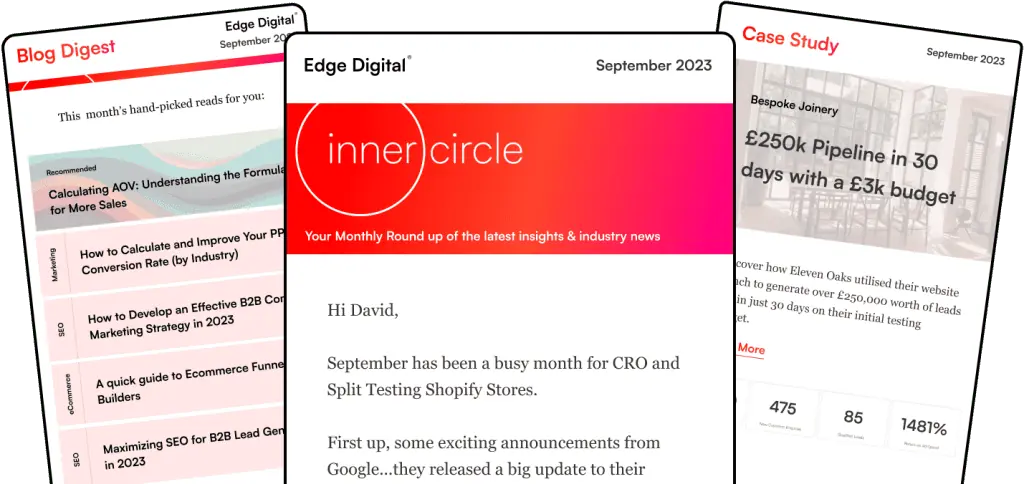Value-based bidding in Google Ads is a powerful tool for advertisers looking to maximise their return on investment. This smart bidding strategy uses artificial intelligence to optimise bids in real-time, targeting users who are likely to bring more value to your business.
Value-based bidding enables you to focus on maximising the total value of conversions generated by your campaigns, rather than just the number of conversions.
We’ll explore how this approach can help you align your advertising efforts with your business goals and budget constraints.
By specifying the value you want to maximise, such as sales revenue, profit margins, or lead scores, you can tailor your campaigns to deliver the best possible results.
Google AI optimises bids based on various factors, including user behaviour and historical data. This means your ads are more likely to reach the right people at the right time, potentially increasing your overall campaign performance and ROI.
Key Takeaways
- Value-based bidding uses AI to optimise bids for maximum conversion value
- Advertisers can specify custom values to align campaigns with business goals
- The strategy aims to improve overall campaign performance and ROI
Understanding Value-Based Bidding
Value-based bidding is a smart way to get the most out of your Google Ads budget. It focuses on maximising the value of conversions rather than just their number.
Defining Value-Based Bidding (VBB)
Value-based bidding is a Google Ads strategy that aims to maximise the total value of conversions. It uses AI to optimise bids in real-time, targeting people likely to bring more value to your business.
With VBB, we specify the value we want to maximise, such as:
- Sales revenue
- Profit margins
- Lead scores
This approach differs from traditional bidding methods that focus solely on the number of conversions. VBB takes into account the quality and worth of each conversion, making it a more nuanced strategy.
Benefits of VBB for Online Advertising
VBB offers several advantages for advertisers:
- Improved ROI: By focusing on value, we can achieve better returns on our ad spend.
- Automatic optimisation: Google’s AI adjusts bids in real-time, saving us time and effort.
- Flexibility: We can set a target ROAS (Return on Ad Spend) or let the system work within our budget.
- Better alignment with business goals: VBB allows us to tie our advertising directly to our financial objectives.
By using VBB, we can make more informed decisions about our ad spend and improve our overall campaign performance.
Value-Based Bidding vs. Traditional Bidding Methods
VBB differs from traditional methods in several key ways:
- Focus: VBB prioritises conversion value, while traditional methods often aim for conversion volume.
- Complexity: VBB requires more setup, as we need to assign values to conversions. Traditional methods are often simpler.
- Data requirements: VBB needs more detailed data about conversion values and business metrics.
- Flexibility: VBB can adapt to changing market conditions more effectively than manual bidding.
While traditional methods still have their place, VBB offers a more sophisticated approach for advertisers looking to maximise their return on investment.
Setting Up Value-Based Bidding in Google Ads
Value-based bidding helps maximise conversion value within your Google Ads campaigns. We’ll walk through the key steps to set it up properly and integrate it with other Google tools.
Defining Conversion Actions
To start with value-based bidding, we need to set up meaningful conversion actions. These are specific customer behaviours that bring value to our business.
In Google Ads, we’ll go to Tools & Settings > Conversions and click the ‘+’ button to add a new conversion action.
We can choose from options like purchases, sign-ups, or custom actions.
For each action, we’ll assign a monetary value. This could be the actual revenue from a sale or an estimated value for leads.
It’s crucial to be precise with these values. They directly impact how the Google AI optimises bids to reach high-value customers.
Setting Conversion Value and Target ROAS
Once we’ve defined our conversion actions, it’s time to set up our bidding strategy. We’ll navigate to our campaign settings and select ‘Bidding’.
Here, we’ll choose ‘Target ROAS’ as our Smart Bidding strategy. ROAS stands for Return on Ad Spend.
We’ll input our target ROAS percentage. This tells Google Ads how much value we want to generate for each pound spent on ads.
For example, if we set a 300% target ROAS, we’re aiming to earn £3 for every £1 spent on ads.
Google’s AI will then use this target to adjust bids in real-time, focusing on users likely to bring higher value.
Integrating with Google Analytics and Google Tag Manager
To make value-based bidding even more powerful, we’ll integrate it with Google Analytics and Google Tag Manager.
First, we’ll link our Google Ads and Google Analytics accounts. This allows for richer data sharing between the platforms.
In Google Analytics, we’ll set up ecommerce tracking to capture transaction values accurately.
Next, we’ll use Google Tag Manager to implement conversion tracking across our website. This ensures all valuable actions are properly recorded.
We’ll create tags for each conversion action and set up triggers to fire them at the right moments.
By integrating these tools, we create a robust system for tracking and optimising our value-based bidding strategy.
Data and Measurement for Value-Based Bidding

Accurate data and measurement are vital for success with value-based bidding in Google Ads. We’ll explore key aspects of data collection and analysis that help optimise this bidding strategy.
First-Party Data and CRM Integration
First-party data is crucial for value-based bidding. We can integrate our Customer Relationship Management (CRM) system with Google Ads to leverage this data effectively.
This integration allows us to:
- Track customer interactions across touchpoints
- Assign accurate values to different types of conversions
- Create custom audiences based on customer behaviour
By linking our CRM data, we gain a more comprehensive view of the customer journey. This helps Google’s AI optimise bids for users most likely to bring value to our business.
Monitoring E-Commerce Transactions
For e-commerce businesses, tracking transactions is essential for value-based bidding. We need to set up conversion tracking that captures:
- Order values
- Product-specific data
- Customer lifetime value estimates
Google Ads can use this information to adjust bids in real-time. It aims to maximise the total value of conversions within our budget constraints.
We should regularly review our e-commerce data to ensure accuracy. This helps us make informed decisions about our bidding strategy.
Impact of Offline Conversions on VBB
Offline conversions play a significant role in value-based bidding for many businesses. We can import offline conversion data into Google Ads using the Google Click ID (GCLID). This allows us to:
- Track phone calls or in-store visits resulting from online ads
- Assign appropriate values to these offline actions
- Provide a more complete picture of our campaign performance
By including offline conversion data, we give Google’s AI a better understanding of our overall business value. This leads to more effective bid optimisation across both online and offline channels.
Optimising Campaign Performance with VBB
Value-based bidding (VBB) in Google Ads uses AI to boost campaign results. It focuses on getting the most value from each conversion rather than just increasing conversion numbers.
Leveraging Machine Learning for Bidding Decisions
VBB relies on advanced machine learning algorithms to make smart bidding choices. These systems analyse vast amounts of data to predict which users are most likely to bring value to your business.
We’ve seen that VBB can:
- Spot patterns in user behaviour
- Adjust bids based on real-time signals
- Learn and improve over time
This means your ads reach the right people at the right time, maximising your return on ad spend (ROAS).
Adjusting Bids for Maximum Conversion Value
With VBB, we can set up campaigns to maximise conversion value within a given budget. This approach goes beyond simply chasing more conversions.
Key benefits include:
- Focusing on high-value customers
- Optimising for profit, not just sales
- Adapting to changes in market conditions
By setting clear goals and providing accurate conversion values, we help Google’s AI make better bidding decisions for our campaigns.
Real-Time Optimisation and Audience Segmentation
VBB excels at real-time optimisation, constantly fine-tuning bids based on the latest data. It also uses audience segmentation to target the most valuable users.
This dual approach allows us to:
- Respond quickly to changes in user behaviour
- Tailor our bids to different audience segments
- Allocate budget more effectively across campaigns
By combining these strategies, we can significantly improve our campaign performance and get more value from our ad spend.
Advanced Techniques in Value-Based Bidding
Value-based bidding offers powerful tools to optimise Google Ads campaigns. By focusing on key metrics and leveraging data, advertisers can boost their return on investment and achieve better results.
Competitive Advantage Through VBB
Value-based bidding (VBB) gives us an edge over competitors. We can set bids based on the real value each click brings to our business. This means we’re not just chasing clicks, but aiming for the most profitable ones.
To get started, we need to track conversion values accurately. This might include sales revenue, profit margins, or lead scores. By feeding this data into Google’s AI, we can bid more for high-value customers.
We should test different value metrics to find what works best. For example, we might bid higher for customers likely to make repeat purchases. This approach helps us grow our market share while keeping costs in check.
Incorporating Customer Lifetime Value (CLV)
Customer Lifetime Value is a game-changer for VBB. Instead of looking at single purchases, we consider the total value a customer brings over time. This shifts our focus to long-term profitability.
To use CLV in our bidding strategy, we need to:
- Calculate CLV for different customer segments
- Assign these values to conversion actions
- Use the ‘Maximise conversion value’ bid strategy
By doing this, we’re telling Google to find more customers like our best ones. This can lead to better quality leads and higher overall revenue.
Adapting Strategies for Lead Generation and Video Action Campaigns
Lead generation and video campaigns need a unique approach to VBB. For lead gen, we assign values to leads based on their likelihood to convert. This helps us focus on quality over quantity.
We might use a scoring system like this:
- Hot lead: £100
- Warm lead: £50
- Cold lead: £25
For video action campaigns, we can use VBB to drive valuable actions beyond just views. This could include sign-ups, app installs, or purchases.
In both cases, it’s key to test and refine our value assignments. What we think is valuable might not always match real-world results.
Financial Aspects of VBB
Value-based bidding (VBB) in Google Ads affects key financial metrics. We’ll explore how VBB impacts ROI, profit margins, customer costs, and budget choices.
Analysing Return on Investment (ROI) and Profit Margins
VBB aims to boost ROI by focusing on high-value conversions. It uses AI to bid more for users likely to bring greater value. This can lead to better profit margins.
We’ve seen that VBB often results in higher conversion values. It may cost more per click, but the payoff can be worth it.
To use VBB well, we need to:
- Track conversion values accurately
- Set clear ROI goals
- Review and adjust bids regularly
A good VBB strategy can lead to more efficient ad spend. It helps target users who are more likely to make big purchases or become loyal customers.
Customer Acquisition Cost (CAC) and Average Order Value (AOV)
VBB can change how we look at CAC and AOV. Instead of just trying to get more customers, we focus on getting valuable ones.
With VBB, we might see:
- Higher CAC but better long-term value
- Increased AOV as we target high-value customers
- More repeat customers and higher lifetime value
It’s crucial to balance CAC with customer lifetime value. VBB helps us do this by bidding more for users likely to make larger or repeat purchases.
We can use VBB to target specific customer segments. This might mean paying more for some clicks but getting better overall results.
Budget Allocation and Performance Measurement
VBB changes how we allocate budgets and measure success. We need to look beyond just clicks and conversions.
Key points for budget planning with VBB:
- Set budgets based on expected value, not just volume
- Allow for higher bids on high-value prospects
- Be prepared for initial fluctuations as the system learns
To measure VBB performance, we track:
- Total conversion value
- Return on ad spend (ROAS)
- Value per conversion
VBB campaigns need at least 50 conversions with value in 35 days to work well. We must ensure our campaigns meet this threshold for best results.
By focusing on value, we can make smarter budget choices. This often leads to better overall campaign performance and higher profits.
Frequently Asked Questions
Value-based bidding in Google Ads helps advertisers maximise their returns. It uses AI to optimise bids based on the value each conversion brings to a business. Let’s explore some common questions about this approach.
How does one implement a value-based bidding strategy in Google Ads?
To set up value-based bidding, we first need to create a new conversion action in Google Ads. We choose ‘Value’ as the conversion value type. Then, we assign values to different conversions based on their importance to our business.
Next, we select a value-based bidding strategy for our campaign. This could be Maximise Conversion Value or Target ROAS (Return on Ad Spend).
Can you describe the difference between conversion-based and value-based bidding approaches?
Conversion-based bidding aims to maximise the number of conversions. It’s useful when all conversions have similar value.
Value-based bidding, on the other hand, optimises for the total value of conversions. It’s ideal when different conversions have varying importance to our business.
Which bidding strategy is recommended for maximising returns in Google Ads?
For maximising returns, we often recommend value-based bidding strategies. These include Maximise Conversion Value and Target ROAS.
These strategies use Google’s AI to optimise bids in real-time. They target users likely to bring more value to our business.
What are the distinct variations of value-based Smart bidding strategies available?
Google Ads offers two main value-based Smart bidding strategies:
- Maximise Conversion Value: This aims to get the highest total conversion value within our budget.
- Target ROAS: This tries to achieve a specific return on ad spend that we set.
Both use AI to adjust bids based on the likelihood of valuable conversions.
In what ways does value-based bidding integrate with Search Ads 360?
Value-based bidding works seamlessly with Search Ads 360. It allows us to manage value-based bidding across multiple search engines from one platform.
We can set up conversion values and choose value-based strategies in Search Ads 360. The system then optimises our bids across all connected accounts.
What should be considered when transitioning to value-based bidding in Google Ads?
When moving to value-based bidding, we need to think carefully about how we assign values to conversions. This might involve analysing our sales data or customer lifetime value.
We should also ensure we have enough conversion data for the AI to work effectively. It’s often best to start with a campaign that already has a good conversion history.



